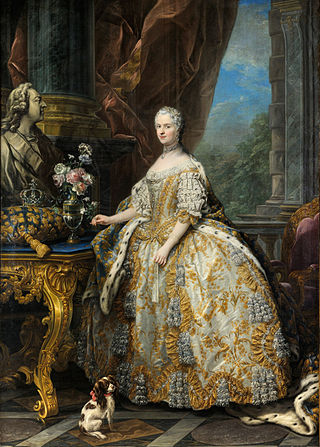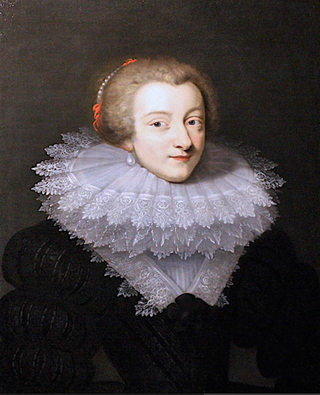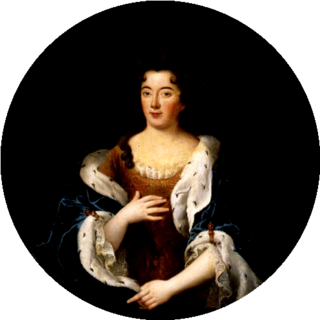Life
Marie Brûlart was the daughter of Nicolas Brûlart, Marquis of La Borde, and Marie Bouthillier. In 1704 she married Louis Joseph de Béthune, marquis de Chârost (1681–1709), who was killed fighting against the British forces of the Duke of Marlborough at the Battle of Malplaquet, four days after the marquise gave birth to their only child: Marie Therese de Béthune-Chârost (1709–16), who died young. As a widow, she remarried as her second husband (and his second wife) Charles Philippe d'Albert (1695–1758), the fourth duc de Luynes , in 1732.
Court life
On 18 October 1735, she was appointed to succeed Catherine-Charlotte de Boufflers as dame d'honneur of the queen. A relation to a previous court official was a qualification to a court office, and she was the sister-in-law to the duchess de Béthune, who had been one of the twelve original Dame du Palais appointed to the queen in 1725. [1] The position of dame d'honneur was formally the deputy and second in rank among the queen's female courtiers after the surintendante , but it was transformed to become the first in rank and chief lady-in-waiting when the position of surintendante was left vacant after 1741, which made her the first ranked of all ladies-in-waiting for the duration of her time in the position. [2] As such, she was responsible for the rest of the queen's ladies-in-waiting.
Marie Brûlart was the personal friend and confidante of the queen, and described as one of her two favorites among her ladies-in-waiting, the other one being duchess Françoise de Mazarin (d. 1742) and, after her death, Amable-Gabrielle de Villars. She was a part of the intimate circle of friends with whom the queen retired to her apartments after having fulfilled her ceremonial duties, consisting also of her grand almoner Cardinal de Luynes, Duke Charles Philippe d'Albert de Luynes, President Hénault, her Surintendant since 1753, and Count d'Argensson. [3] From 1751, Marie Brûlart allowed her duties to be handled by her deputy, her daughter-in-law Henriette-Nicole Pignatelli d'Egmont, duchess de Chevreuse (1719-1782), but she formally kept her rank and title of dame d'honneur and kept attending court in her capacity of the queen's friend. When de Chevreuse resigned in 1761, Marie Brûlart resumed the duties of her office again and retained them until her death.
Her husband left memoirs of the couple's life at court, leaving many interesting observations of the royal family, and of the king's mistress, Madame de Pompadour, whom the duke and duchess appear to have grown to respect over a period of time, though this grudging admiration did not affect the duchess's friendship or loyalty to Queen Marie Leszczyńska. Madame de Luynes died aged 79, and was the mother, by her second marriage, of Marie Charles Louis d'Albert, duc de Chevreuse (1717–1771).

Maria Karolina Zofia Felicja Leszczyńska, also known as Marie Leczinska, was Queen of France as the wife of King Louis XV from their marriage on 4 September 1725 until her death in 1768. The daughter of Stanisław Leszczyński, the deposed King of Poland, and Catherine Opalińska, her 42-years and 9 months service was the longest of any queen in French history. A devout Catholic throughout her life, Marie was popular among the French people for her numerous charitable works and introduced many Polish customs to the royal court at Versailles. She is also one of the popularizers of the hurdy gurdy in the court of Louis XV, she played the instrument and made the gurdy famous. She was the grandmother of the French kings Louis XVI, Louis XVIII and Charles X.

Marie Aimée de Rohan was a French courtier and political activist, famed for being the center of many of the intrigues of the first half of the 17th century in France. In various sources, she is often known simply as Madame de Chevreuse.

Anne Henriette of France was a French princess, the twin of Louise Élisabeth of France. She was the second child of King Louis XV and his popular queen consort, Marie Leszczyńska. She was also considered the favorite daughter of the royal couple and was known for her sweet and gentle personality.

Anne Marie d'Orléans was Queen of Sardinia by marriage to Victor Amadeus II of Savoy. She served as regent of Savoy during the absence of her spouse in 1686 and during the War of the Spanish Succession. She is also an important figure in British history.

Anne d'Arpajon, comtesse de Noailles was a French noblewoman and court official. She served as the dame d'honneur of two Queens of France, Marie Leszczyńska and Marie Antoinette. She was called "Madame Etiquette" by Marie Antoinette for her insistence that the minutiae of court etiquette could never be altered or disregarded.

Wilhelmine Amalie of Brunswick-Lüneburg was Holy Roman Empress, Queen of the Germans, Queen of Hungary, Queen of Bohemia, Archduchess consort of Austria etc. as the spouse of Joseph I, Holy Roman Emperor.

Louise Diane d'Orléans was Princess of Conti from her marriage to Prince Louis François in 1732, until her death in childbirth. She was the youngest child of Philippe II, Duke of Orléans and Françoise Marie de Bourbon, the youngest legitimised daughter of King Louis XIV of France and his mistress Madame de Montespan. She was born while her father was the regent for Louis XV. Some sources referred to her as Louis Diane.
Charles Philippe d’Albert, 4th Duke of Luynes held the title Duke of Luynes from 1712 to 1758. He wrote an important memoir of life at the court of Louis XV.

Marie Louise Élisabeth of France, also referred to as Louise Élisabeth of France by secondary sources, was a French princess. She was the eldest daughter of King Louis XV of France and the popular Queen Maria Leszczyńska, and the twin sister of Princess Henriette of France. She married Infante Philip of Spain, who inherited the Duchy of Parma through his mother in 1748. Infante Philip was her father's first cousin; both men were grandsons of Louis, Grand Dauphin. Thereafter, Élisabeth and her husband founded the House of Bourbon-Parma. She functioned as the de facto ruler of the Duchy of Parma between 1748 and 1759.

Maria Vittoria of Savoy was a legitimated daughter of Victor Amadeus II of Sardinia, first king of the House of Savoy. Married to the head of a cadet branch of the House of Savoy, she is an ancestor of the kings of Sardinia and of the Savoy kings of Italy.

Marie Isabelle de Rohan was a French noblewoman and grand daughter of Madame de Ventadour. Marie Isabelle was the governess of the children of Louis XV and his consort Marie Leszczyńska.

Première dame d'honneur, or simply dame d'honneur, was an office at the royal court of France. It existed in nearly all French courts from the 16th-century onward. Though the tasks of the post shifted, the dame d'honneur was normally the first or second rank of all ladies-in-waiting. The dame d'honneur was selected from the members of the highest French nobility.

Surintendante de la Maison de la Reine, or only Surintendante, was the senior lady-in-waiting at the royal court of France from 1619 until the French revolution. The Surintendante was selected from the members of the highest French nobility.

Laure Auguste de Fitz-James, Princesse de Chimey was a French courtier. She served as lady-in-waiting to Queen Marie Antoinette from 1770 to 1791.

The Dame du Palais, originally only Dame, was an historical office in the Royal Court of France. It was a title of a lady-in-waiting holding the official position of personal attendant on a female member of the French Royal Family. The position was traditionally held by a female member of a noble family. They were ranked between the Première dame d'honneur and the Fille d'honneur. They had previously been styled 'Dames'.

Hortense Félicité de Mailly-Nesle, Mademoiselle de Chalon, marquise de Flavacourt (1715–1799) was a French courtier, one of the five famous de Nesle sisters, four of whom would become the mistress of King Louis XV of France. Unlike each of her four sisters, she never became the king's mistress, though she was often the subject of speculations.

Catherine Charlotte de Gramont (1670–1739) was a French court official, foremost known as the Marechale de Boufflers. She served as Première dame d'honneur to the queen of France, Marie Leszczyńska, the wife of King Louis XV, from 1725 until 1735.
Françoise de Mailly (1688–1742), was a French court official. She served as the dame d'atour to queen Marie Leszczyńska in 1731–1742.
Anne-Marie-Francoise de Sainte-Hermine, was a French court official. She served as the dame d'atour to Françoise Marie de Bourbon from 1692 to 1696, to Marie Adélaïde de Savoy from 1697 to 1712, and to queen Marie Leszczyńska from 1725 to 1731. She was a central figure in the French royal court and mentioned in contemporary memoirs.

Armande Félice de La Porte Mazarin (1691–1729), was a French noblewoman, courtier and duelist. She is known for the famous duel she fought over her lover with another woman, for being a figure of scandal during the Regency period, and for being the mother of the Nesle sisters, mistresses to Louis XV.
















